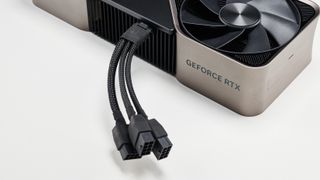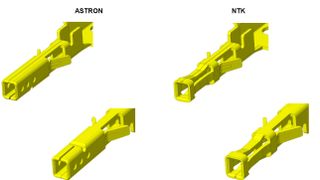PSU manufacturers warned against using 600W GPU power plug design due to temperature rise risk
Intel says power supplies should now come with only one 12VHPWR plug design, 4 Spring.

The design guide for modern power supplies has been updated to recommend just one type of cable plug for graphics cards. It's now recommended that the 12VHPWR connector capable of delivering up to 600W of power to a single GPU should use a plug design called 4 Spring, in a bid to reduce risk of rising temperatures.
The 12VHPWR connector is a pretty new concept in the world of PSUs, first introduced in early 2022 as a part of a wider redesign with the ATX 3.0 specification. The ATX 3.0 specification is basically a how-to guide to building a modern-day PSU for manufacturers, published by Intel, and it ultimately determines how different connectors and standards are actually brought to market.
In a recent update to the ATX 3.0 PSU specification, spotted by user harakaze5719 on Twitter, Intel now recommends just one design, known as 4 Spring, for the 12VHPWR connector, and is actively dissuading manufacturers from using the alternative, known as 3 Dimple.
"Crimp Contacts inside of the cable plug are recommended to use the 4 Spring design instead of 3 dimple design, which will increase the contact area for electrical current flow inside the 12VHWPR connector and reduce the temperature rise of each contact."
Intel then attaches a handy image (courtesy of Wieson* Technologies Co., Ltd.) to show the actual difference between the two, in case you didn't know your spring plugs from your dimples.

The reason why this seemingly minute design change is of any interest is because the exact design of these two connectors has been brought into question by cases of melting GPU connectors on Nvidia's high-end RTX 40-series graphics cards. AMD's latest graphics cards do not use the 12VHPWR connector.
In an Igor's Lab report on the issue back in November, they noted that Nvidia had two suppliers for 12VHPWR adapters: a company called NTK producing the 4 Spring design and another called Astron producing the 3 Dimple design. It's in this same article that Igor's Lab publishes a slide from Nvidia highlighting these two opposing designs, and notes that the NTK design appears the all-round more robust connector.
The biggest gaming news, reviews and hardware deals
Keep up to date with the most important stories and the best deals, as picked by the PC Gamer team.

Igor's Lab didn't lay all the blame for reports of melting power connectors on only these differences in the power plug on the connector. But they did chalk up some of the 12VHPWR's connectors problems to the less-than-ideal 3 Dimple design.
Nvidia has officially chalked up the failures to an improper connection, noting in a customer support update that users need to be absolutely sure they have fully plugged in the 12VHPWR connector into their graphics card.
Improper contact appears to be the problem, then. Whether from a poorly designed plug or an improperly plugged in connector.
Officially changing the ATX 3.0 specification is a step in the right direction to addressing the issue once and for all. But it's important to note that Intel does not actually design the 12VHPWR connector. It's laid out in the PCIe 5.0 specification, which means any changes to the connector are a job for PCI-SIG, a special interest group made up by hundreds of global tech firms.

Last year, PCI-SIG washed its hands of the affair following a class-action lawsuit filed against Nvidia for the melting connectors, noting in a statement sent to PC Gamer: "Members are reminded that PCI-SIG specifications provide necessary technical information for interoperability and do not attempt to address proper design, manufacturing methods, materials, safety testing, safety tolerances or workmanship. When implementing a PCI-SIG specification, Members are responsible for the design, manufacturing, and testing, including safety testing, of their products."
PCI-SIG has made changes to the 12VHPWR spec, though the only material change to the connector as noted so far on the PCI-SIG specification page is in regards to the four sense pins running along the underside of the 12-pin power connectors, and not the actual power pins. I suspect further changes will be made to the spec with time.
Best CPU for gaming: Top chips from Intel and AMD
Best gaming motherboard: The right boards
Best graphics card: Your perfect pixel-pusher awaits Best SSD for gaming: Get into the game first

Jacob earned his first byline writing for his own tech blog. From there, he graduated to professionally breaking things as hardware writer at PCGamesN, and would go on to run the team as hardware editor. He joined PC Gamer's top staff as senior hardware editor before becoming managing editor of the hardware team, and you'll now find him reporting on the latest developments in the technology and gaming industries and testing the newest PC components.
Most Popular







